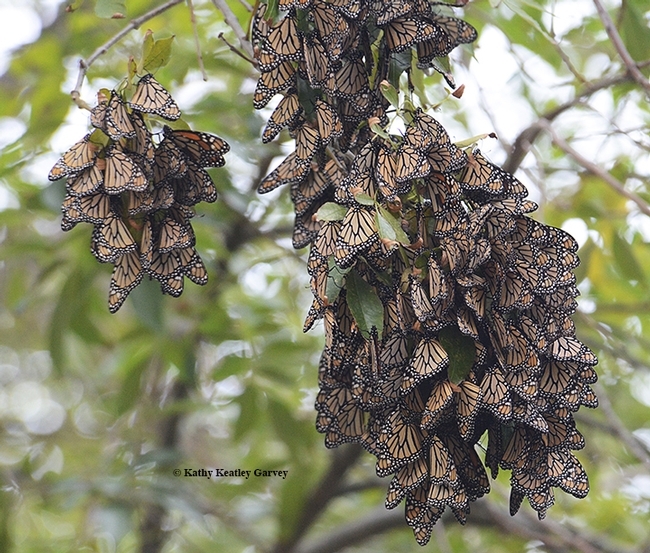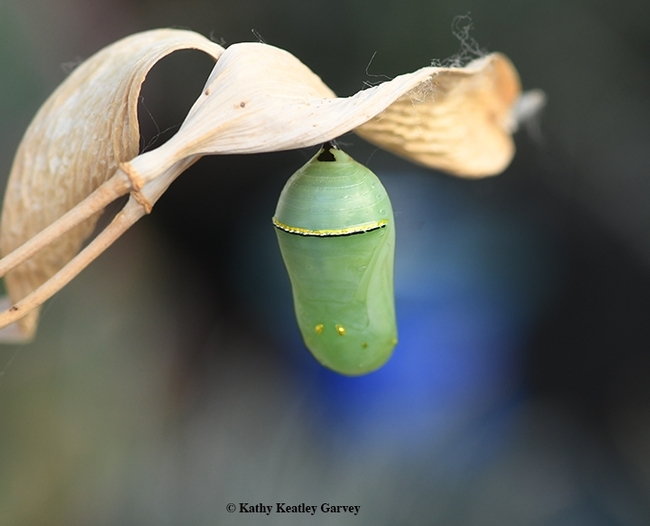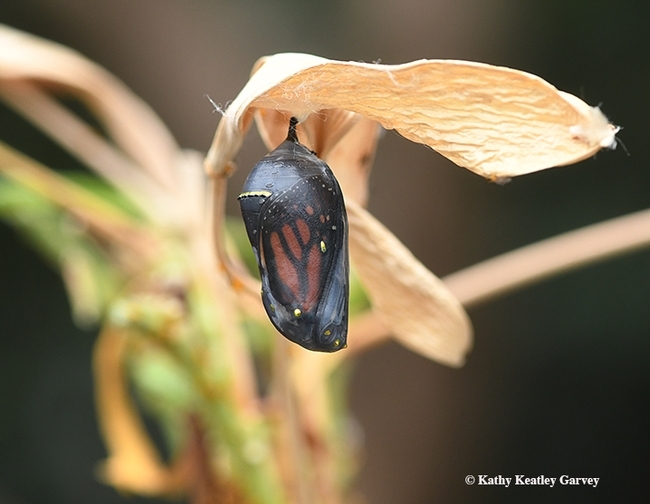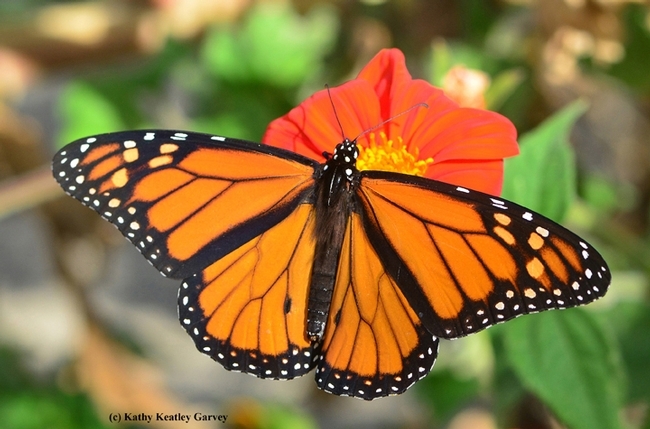- Author: Kathy Keatley Garvey
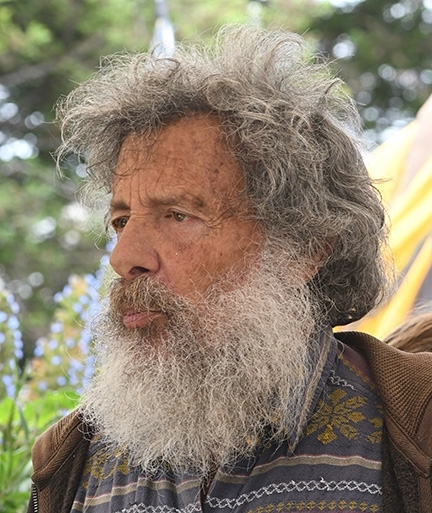
A group of invited guests--invited by the Environmental Defense Fund--met Feb. 28 at UC Davis to discuss "Recovering the Western Monarch Butterfly Population: Identifying Opportunities for Scaling Monarch Habitat in California's Central Valley."
"The western population of the monarch butterfly has garnered widespread attention because of its dramatic decline in recent decades," the document containing the agenda read. "The latest population surveys indicate that monarchs overwintering on the central coast have declined 86% since last winter and now total 0.5% of their historical average. Population declines have spurred greater scientific study, funding, and coordination around the western monarch. California legislators appropriated $3 million in funding to the CA Wildlife Conservation Board to establish the Monarch Butterfly and Pollinator Rescue Program."
"Additionally, the Western Association of Fish and Wildlife Agencies released a Western Monarch Butterfly Conservation Plan calling for an additional 50,000 acres of monarch-friendly habitat in the California Central Valley and adjacent foothills by 2029. Join Environmental Defense Fund along with farmers, restoration practitioners, and scientists for an invitation-only workshop to share expert knowledge and identify strategic opportunities for restoring monarch butterfly habitat across the Central Valley. We will discuss important topics including opportunities for monarch habitat in the food production landscape, incentivizing monarch habitat restoration using limited resources, production and distribution of native plants, and other subjects that will put the western monarch butterfly population on the path to recovery. We will use the results of the workshop to inform conservation initiatives and effectively and efficiently allocate funds and resources for optimal conservation outcomes."
Among the five speakers in the "State of the Science" workshop section was Art Shapiro, UC Davis distinguished professor of evolution and ecology, who has been monitoring Central Valley's butterfly population since 1972 and maintains a website on his research.
We thought we'd share his PowerPoint, "What We Don't Know and What We Know That Ain't So About Monarchs" in which he declared that "monarchs are on life support in California, and we are reduced to prescribing placebos."
His PowerPoint:
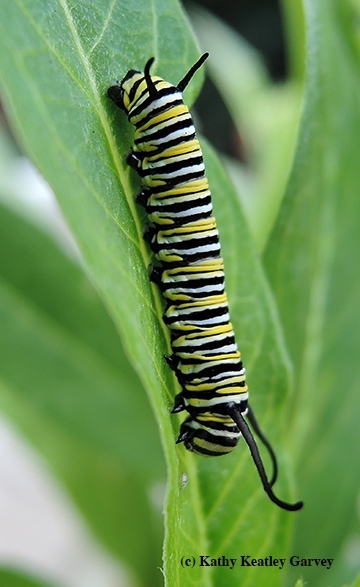
- Monarchs are in trouble in California--but they're hardly alone. If we act as if this is a "Monarch problem," we're in danger of missing the real causes of Monarch decline--factors acting at a much broader scale.
- We've been monitoring entire butterfly faunas--over 150 species--along a transect across California since 1972. Our monitoring sites are matched with climatological data, allowing us to examine statistical relations between climate and butterfly trends. Based on this data set, our group was the first to document and publish evidence of monarch decline here. That's the only reason I'm here. I'm NOT a monarch specialist, and monarchs are not a focal species in my research."
But as I Said, Monarchs Are Not Alone
- At low elevations—below 1000'—entire butterfly faunas have been in long-term decline. We published several papers showing that these declines were about equally correlated with land-use changes and pesticide (especially neonicotinoid) use, with climate change a significant factor but much less important. Remember, these are correlations, not necessarily demonstrations of causation—but they are strongly suggestive. Monarchs were just one of many species going downhill; three once-common species (the Large Marble, Field Crescent and “Common” Sooty-wing) had already gone regionally extinct or nearly so, with others threatening to follow suit.
And Then we Had the 'Millennial' Drought
- Most people would have predicted that five years of drought would drive the last nails into the coffin of our butterfly fauna. But they didn't!
- During the drought years all our low-elevation faunas rebounded to where they had been before the declines accelerated in 1999. The rebound was manifest in numbers of species flying AND in individual species abundances! Most species peaked in 2015. Here's just one example, the Buckeye. Here are total Valley counts by year:
- 2012:490. 2013:884. 2014:1231. 2015:3818. 2016:2399. 2017:2340. 2018:379. WHOA! What happened in 2018?
What About the Monarch?
- Again, the drought-year uptick was broadly-based across many species—NOT cherry-picked. The Monarch was just one more species that rebounded. Here are the numbers counted in the Valley:
- 2012:38 (the bottom of the decline) 2013:40 2014:42 2015:164
2016:80 2017:75 2018:36 (we're back where we started…) - Why was 2018 so very, very bad for so many species? The rule of thumb known as 'Occam's Razor' says that the simplest (or broadest) explanation should be tested first (NOT that it is most likely to be true!). If the broad-based trends outlined here have a common explanation, it can't be due to Monarch-specific life-history characteristics (like feeding on milkweeds)!
Well, It Ain't Due to Any Milkweed Shortage!
- Even if we ONLY look at Monarchs, there has NEVER been any convincing evidence that declines were being driven by a shortage of Milkweed, either in the East/Midwest or out here. (That's true even if many people would like to put the blame on GMOs and Monsanto.)
- If the decline back East were Milkweed-driven, how could 2018 have been an outstanding Monarch year there—”best in a decade!”—as now reflected in the Mexican overwintering numbers? What did their caterpillars eat—press releases?
- Along my transect, 2018 was a fabulous year for Milkweed—but the Monarch crashed. Plenty of plants; no butterflies to lay on them
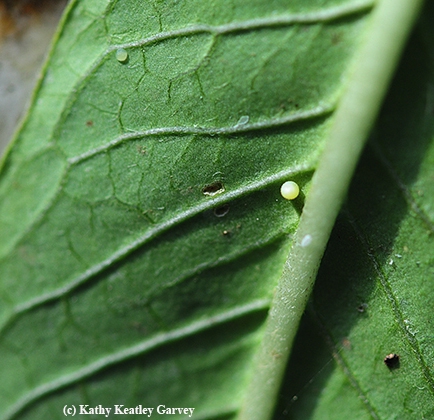
- On my transect, Monarchs historically arrived from the coast in March and bred in the Valley.* During the summer there was always some Valley breeding, but the “frontier” of breeding spread eastward in spring into the Sierran West slope and eventually to the East slope and Great Basin. A westward “drift” over the Sierran crest and down the West slope in late summer reinforced Valley breeding, but there was no great uptick noted.
• Beginning in the late 1990s, however, Monarchs moving inland in spring stopped breeding in the Valley but instead apparently continued East into the Sierra. By 2012 it was almost impossible to find larvae in the Valley until late summer. Instead, the butterflies moving westward from August onward began breeding heavily in the Valley, and there were larvae to be found from August even into November.
• Basically, the Monarch breeding season in the Valley had switched from spring early summer to late summer-autumn!
*It's worth noting that in years when Monarchs arrived before Valley milkweeds broke ground, there
appeared to be some “backwash” into the Coast Range to breed on Asclepias cordifolia.
Again, the Drought Changed All That!
- During the drought the Monarch reverted to its pre-decline seasonal rhythm, breeding in spring and summer in the Valley. During its population peak in 2015, larvae were abundant and easily found in summer, including on plants in gardens, for the first time since the late 1980s-early 1990s. But this pattern collapsed in 2017, and whatever breeding we saw in the Valley was again late in the season. And in 2018 there was NONE. I never saw a single wild Monarch larva in 2018—the first time since I became butterfly-aware in 4th or 5th grade!
And Then There's the Matter of Winter Breeding
- Overwintering Monarchs are supposed to be in reproductive diapause, which is triggered by seasonal photoperiod just as in birds. The animals clustered in the trees are uninterested in sex until late January or February, when everyone mates with everyone else just before taking off to move inland and breed.
• Except…beginning around a decade ago in SoCal and spreading North to the Bay Area, increasing numbers of winter Monarchs are NOT in reproductive diapause, do NOT join the clusters, and attempt to
breed all winter long. We do NOT understand why this is happening.
What Do You Breed on in the Winter?
- Native Milkweeds go winter-dormant. Winter breeding, then, is only possible on exotic species in gardens that do not go winter-dormant. By far the most abundant of these is Tropical Milkweed, Asclepias curassavica.
- This plant has been in cultivation in California for about a century. It was abundant when I first visited California in 1966. In fact, it was all over my point of entry, LAX. Monarchs bred on it in summer—but not in winter. Emmel and Emmel, in The Butterflies of Southern California, emphasize that there is no breeding in winter. Nor can I find any
reference to winter breeding before the late 2000s.
So Why Are They Breeding in Winter?
- Some people—mainly native-plant enthusiasts—have tried to make a case that the presence of exotic Milkweeds in cultivation causes winter breeding. But as noted before, it has been in cultivation here for many decades and never caused winter breeding before. It would appear that it merely enables winter breeding, which is hardly the
same thing. But why would there be animals in breeding condition at all in winter, and why now? My best guess—that's all it is—is that climate change is to blame: that rising temperatures are shifting the photoperiodic threshold for induction of reproductive diapause. This is a testable hypothesis.
And Then There's the OE (Ophryocystis elektroscirrha) Matter
- Because Monarchs rarely breed on the same individual plants repeatedly in the same year in Nature, there is little opportunity for the plants to become contaminated with infective spores of the debilitating parasite OE.
- But in winter, garden plants are all that's available, so they tend to get used and re-used over and over and develop heavy OE spore loads—mainly in SoCal, not yet so much in the Bay Area.
- So the native-plant zealots say we need to get rid of exotic Milkweeds, thereby making winter breeding impossible and preventing large-scale OE infection.
But They Would Say That, Wouldn't They?
- Just like anti-GMO activists really want to pin Monarch declines on Monsanto, native-plant activists really want to claim non-native garden Milkweeds are a problem (if not the problem).
- There is no evidence that winter breeding is harmful, except for the OE exposure. It's just different. Change is not necessarily harmful. Change is the usual order of things.
- The OE risk is easily manageable by periodically cutting back one's tropical Milkweed and discarding old, potentially contaminated foliage. You're increasing new, healthy, clean growth and a side benefit is a degree of control of the Oleander Aphid, Aphis nerii, bane of all Milkweed growers.
What We Really Need Is Good Demographic Data!
- Rather than indulging in speculation about what is driving Monarch declines—speculation that gets “validated” by repetition in the media – we need hard data on age-structured survivorship and mortality, like we get for other insect population studies. We need Monarch “life tables.”
- If we had such data we could potentially identify the real drivers of population fluctuations in a much more satisfying way than we can now—using nothing but the annual overwintering census data. Those data summarize everything that happened since the previous winter count without telling us anything about what actually did happen
Why Don't We Have Monarch of Life Tables?
- Because Monarchs don't have populations in the sense one usually thinks of populations. All West Coast Monarchs are one big population, held together by gene exchange at the end of the roosting period. Monarchs are extremely mobile and as noted before, except in the artificial winter-breeding environment, they rarely breed twice in the same place in the same year. The result is that we literally do not know—and cannot know—where they are most of the time. We have more-or-less haphazard encounters that tell us where a few of them are. There have been times when I had none in my sites but a friend with family property at the nearby town of Knight's Landing reported Monarchs breeding like crazy. That's normal. That's Monarch biology. Moving around like that is probably a very effective strategy to “lose” parasites and predators—they don't know where you are either.
That Table Doesn't Mean We Can't Get Life Table Data
- A team HQed at UNR has surveyed and attempted to characterize habitat for the Western Monarch. The paper is in preparation. No such survey can tell us where Monarchs are going to breed in a given season, but it can generate predictions—predictions that allow us to test the hypothesis that MONARCHS ARE CHOOSING BREEDING
SITES IN AN OPTIMIZING MANNER. - That is, when Monarchs decide where to breed, they are employing hard-wired adaptive responses to environmental cues that predict reproductive success. They are “choosing wisely.” The changes in seasonal breeding rhythm that we observed on our transect, then, would be seen as adaptive to changing boundary conditions.
We Can Experimentally Create Our Own 'Populations' to Track
- In my lab we have generated life tables for other species, particularly the Anise Swallowtail (Papilio zelicaon), in order to test hypotheses reflecting alternate models of survivorship.
- We do this by putting lab-generated cohorts of eggs or neonate larvae in the field, in situations carefully chosen to reflect suspected factors affecting survivorship. We then track them daily until the last one has disappeared, pupated, or emerged. We have done this on multiple host plants used afield, both native and introduced, and throughout
the range of the species, from sea level to the subalpine zone and on the Sierran East slope. There is no obvious reason why the same protocols couldn't be used to develop Monarch life tables.
Of Course, There Are Limitations on Generalizability from Such Studies
- Conditions where we put out our animals may not be a very good match for where they are actually breeding at the moment. The previously referenced survey may be helpful for that. Because we lack data on the dispersion of Monarch larvae afield – their instantaneous locations in space – we could do a poor job of trying to generate a more-or-less natural spatial pattern. This can be important if mortality is significantly density dependent. Unnatural aggregation could facilitate disease transmission and parasitism, and could be especially important if predation is primarily visual and is a function of “search images,” either positive or negative. The takehome is that such experiments must be cleverly and sophisticatedly designed to maximize our returns from them. (Monarchs, like most butterflies, seem to show “edge effects” in host utilization. We know that and can build it into our studies.)
So, What Do We Need to Do?
- We need to recognize that the Western Monarch decline may reflect factors operating at a higher level and not specific to the Monarch's life-history. If so, Monarch-centric “solutions” will not work.
- We need to recognize that the remedial actions being recommended—especially planting Milkweed—are basically “feel good” activities that may do no good and at best may do little harm, beyond wasting scarce conservation resources that could be better used elsewhere.
- We need to recognize and acknowledge that our actual understanding of Monarch declines is rudimentary and does not justify many of the conclusions being put forward. And…
We Need to Identify the Precise Kinds of Data We Need, Identify the Best Strategies to Get Them and Get to Work!
- Consider a doctor faced with a patient in rapid decline. All tests have failed to identify the cause. What is the doctor to do? You can't prescribe treatment for an undiagnosed illness, can you? You can make a wild stab at a prescription on the basis that the patient is going to die anyway, and MAYBE, just maybe, this drug will do some good. Or you can prescribe a placebo, just to reassure the patient that you are doing something. That's where things get interesting. Occasionally a patient improves drastically on a placebo. Maybe he would have improved anyway; there's no way of knowing. Suppose our patient has a complete remission despite having received only a placebo. Does our doctor convince himself the placebo cured him?
As of right now, the Monarch is on life support in California, and we are reduced to prescribing placebos. If our patient comes back from the brink—as history suggests it may well—will we convince ourselves that our placebos worked? Probably. And that's not how to do science. That's what philosophers call the fallacy of post hoc, ergo propter hoc.
We can do can do better than that!
...A Postscript
- In his book “Not a Scientist,” Dave Levitan identifies the various strategies employed by science deniers to confuse the public. One, which he calls “certain uncertainty,” is the argument—usually used about climate change—that “we don't know enough to take meaningful action.” That is typically employed by economic interests that would be adversely affected if action were to be taken. I want to make it clear here that I have no economic or ideological conflict of interest here. I am not a shareholder in Monsanto. To say we don't know enough to act is only a lie if we DO know enough. We clearly don't know very much about why Monarchs are in decline. Do we really know enough to take meaningful action? That's what we're here to discuss, isn't it?
That ended the professor's thought-provoking, call-to-action presentation.
Stay tuned.
